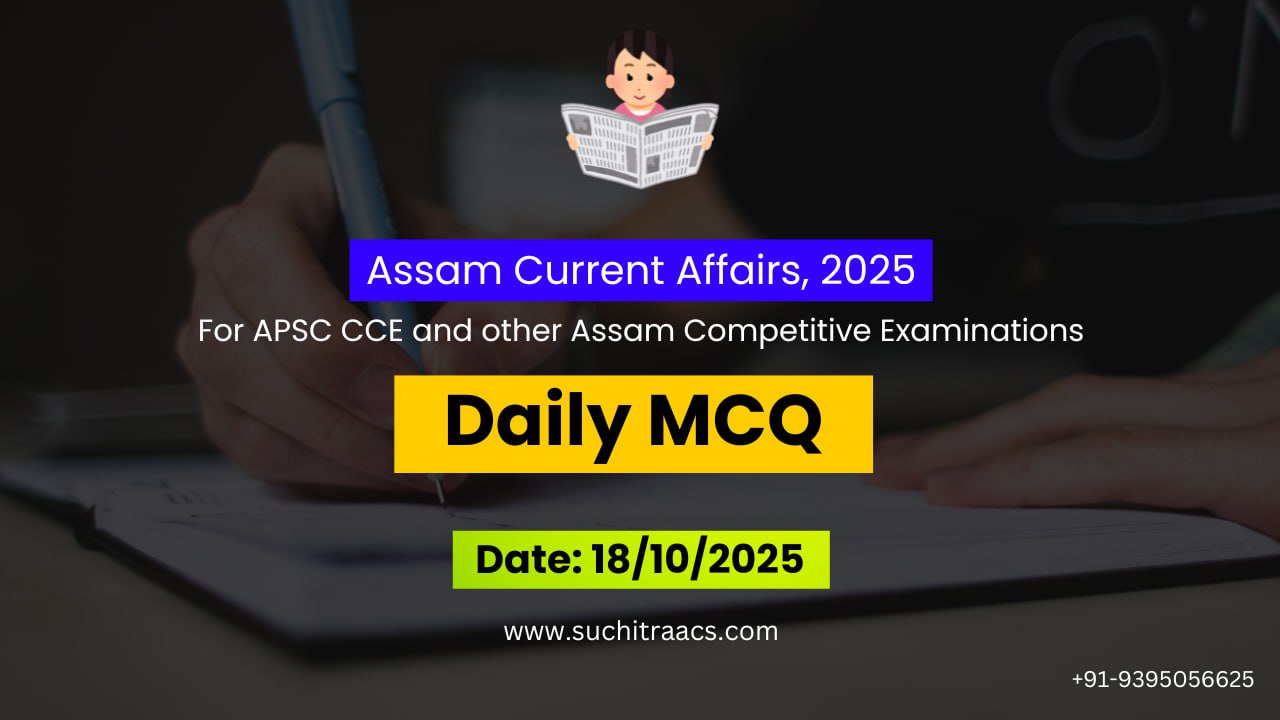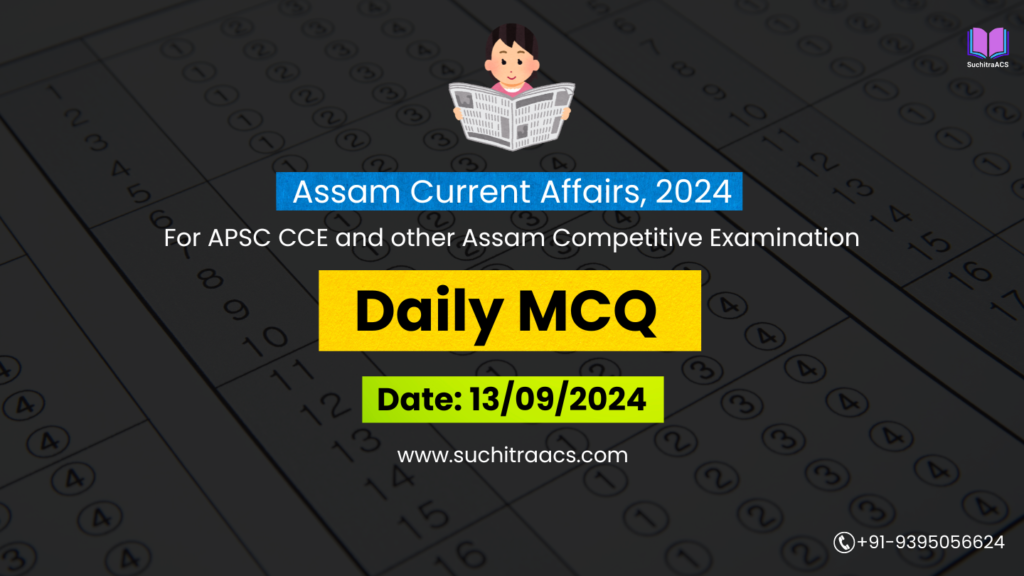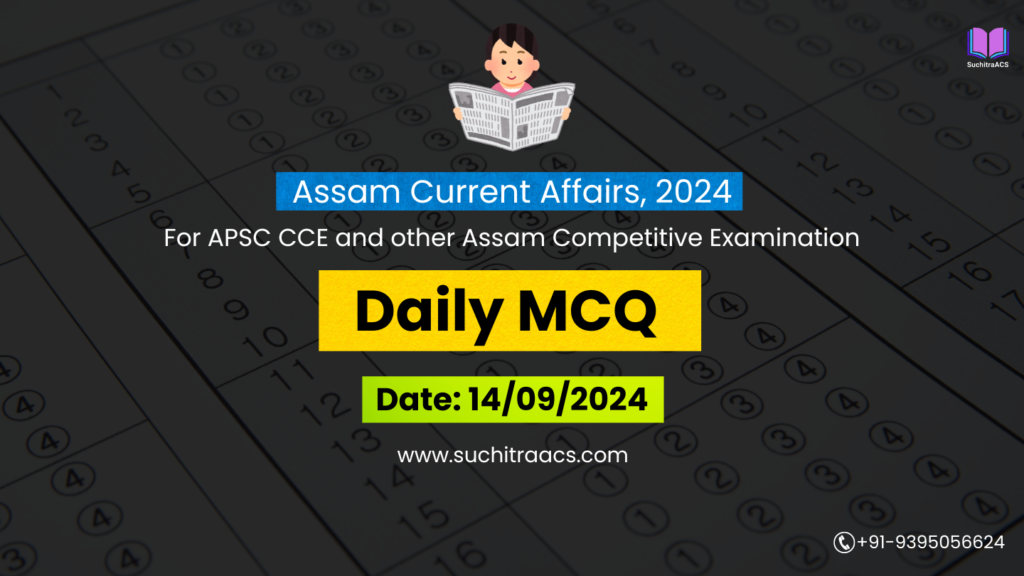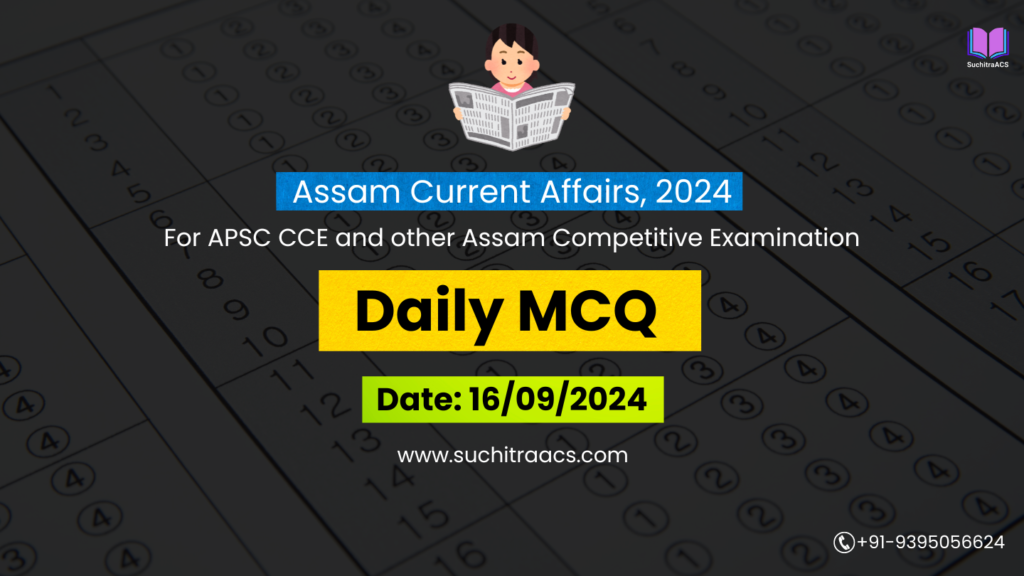APSC MCQs / APSC Prelims Practice Questions based on Assam Tribune (Daily) –18/10/2025
For APSC CCE and other Assam Competitive examinations aspirants, practicing Daily MCQs is vital. This blog covers most important Prelims questions from the Assam Tribune today (18-10-2025). These issues are key for both APSC Prelims syllabus, offering insights into the important topics of current affairs.
✨ APSC CCE Online Coaching, 2026

APSC MCQs / APSC Prelims Practice Questions (Date: 18/10/2025)
🧩 Prelims Question Set – Assam Tribune (18 October 2025)
🌏 Topic 1 – India–Myanmar Border Trade and Connectivity Amid Political Unrest
Q1. With reference to India–Myanmar connectivity projects, consider the following pairs:
| Project | Description |
| 1. Kaladan Multimodal Project | Connects Sittwe Port (Myanmar) to Lawngtlai (Mizoram) via inland water and road links |
| 2. IMT Trilateral Highway | Connects Imphal (India) to Bangkok (Thailand) via Mandalay (Myanmar) |
| 3. BIMSTEC Corridor | Connects India directly with Laos and Cambodia via maritime routes |
Which of the pairs given above is/are correctly matched?
(a) 1 and 2 only
(b) 2 and 3 only
(c) 1 only
(d) 1, 2 and 3
✅ Answer: (a)
Explanation:
- Kaladan and IMT projects are operational under India–Myanmar cooperation.
- BIMSTEC is Bay of Bengal Initiative—not a specific corridor to Laos or Cambodia.
Q2. The Kaladan Multimodal Transit Transport Project passes through which of the following Indian states?
- Mizoram
- Nagaland
- Arunachal Pradesh
(a) 1 only
(b) 1 and 2 only
(c) 1 and 3 only
(d) 1, 2 and 3
✅ Answer: (a)
Explanation:
The project connects Sittwe (Myanmar) → Paletwa (Myanmar) → Lawngtlai (Mizoram); only Mizoram lies on the Indian leg.
Q3. The India–Myanmar border trade disruption impacts Assam’s economy primarily because:
(a) Assam’s ports are directly connected to Myanmar’s Sittwe Port.
(b) Assam serves as the logistic hub for IMT Highway and Kaladan projects.
(c) Assam produces 40% of India’s exports to Myanmar.
(d) Assam shares a 1,000-km direct border with Myanmar.
✅ Answer: (b)
Explanation:
Assam’s logistical connectivity via Silchar–Moreh and Barak–Kaladan corridors links its economy indirectly with Myanmar trade.
🏞️ Topic 2 – Deepor Beel Wetland Restoration & Guwahati Water Security Plan
Q4. Which of the following statements about Deepor Beel are correct?
- It is a Ramsar site and part of Deepor Beel Wildlife Sanctuary.
- It lies within the floodplain of the Brahmaputra River.
- It is India’s largest inland saltwater wetland.
(a) 1 and 2 only
(b) 2 and 3 only
(c) 1 and 3 only
(d) 1, 2 and 3
✅ Answer: (a)
Explanation:
Deepor Beel is a freshwater wetland located in the Brahmaputra valley. Declared a Ramsar site in 2002.
Q5. The National Plan for Conservation of Aquatic Ecosystems (NPCA):
(a) Focuses only on river pollution and flood control.
(b) Replaced both NLCP and NWCP in 2013 under MoEFCC.
(c) Is implemented by NITI Aayog.
(d) Operates only in Himalayan states.
✅ Answer: (b)
Explanation:
NPCA merged National Lake Conservation Plan (NLCP) and National Wetland Conservation Programme (NWCP) in 2013.
Q6. Which of the following are the major threats to Deepor Beel’s ecological health?
- Leachate from Boragaon landfill
- Railway embankment blocking natural drainage
- Illegal sand mining from nearby rivers
(a) 1 and 2 only
(b) 1 and 3 only
(c) 2 and 3 only
(d) 1, 2 and 3
✅ Answer: (d)
Explanation:
All three have been identified by the Assam Forest Dept. and High Court as causes of hydrological and ecological degradation.
🌧️ Topic 3 – Guwahati Smart City: Urban Drainage & Climate Adaptation Projects
Q7. The “CITIIS 2.0” programme, recently implemented in Guwahati, is jointly supported by:
(a) World Bank, ADB, and Ministry of Finance
(b) World Bank, AFD (France), and National Institute of Urban Affairs (NIUA)
(c) IMF and NITI Aayog
(d) UNEP and MoHUA
✅ Answer: (b)
Explanation:
CITIIS 2.0 (2023–2030) is funded by World Bank and Agence Française de Développement (AFD), coordinated by NIUA under MoHUA.
Q8. Which of the following technologies are used in Guwahati’s 2025 climate adaptation plan?
- AI-based flood forecasting
- Digital twin modeling for city planning
- Cloud-seeding rainfall augmentation
(a) 1 and 2 only
(b) 2 and 3 only
(c) 1 only
(d) 1, 2 and 3
✅ Answer: (a)
Explanation:
AI and digital twins are part of Guwahati Smart City’s drainage plan; cloud seeding is not included.
Q9. Which of the following drains or basins are part of Guwahati’s natural stormwater network?
- Bharalu
- Basistha
- Bahini
- Kolong
(a) 1, 2 and 3 only
(b) 1 and 4 only
(c) 2, 3 and 4 only
(d) 1, 2, 3 and 4
✅ Answer: (a)
Explanation:
Bharalu, Basistha, and Bahini are within Guwahati city; Kolong flows through Nagaon district.
🏥 Topic 4 – Assam’s Rural Health Mission: Telemedicine & e-Sanjeevani
Q10. Consider the following statements regarding the e-Sanjeevani initiative:
- It was developed by the Centre for Development of Advanced Computing (C-DAC).
- It enables both doctor-to-patient and doctor-to-doctor consultations.
- It operates only in urban tertiary hospitals.
(a) 1 and 2 only
(b) 2 and 3 only
(c) 1 only
(d) 1, 2 and 3
✅ Answer: (a)
Explanation:
Developed by C-DAC Mohali, e-Sanjeevani includes both variants: OPD and AB-HWC, accessible even at rural HWCs.
Q11. Under the Ayushman Bharat Digital Mission (ABDM), the “ABHA” ID refers to:
(a) A national health insurance number under PM-JAY.
(b) A unique digital health identity number linked to medical records.
(c) A code for health workers under NHM.
(d) A registration number for medical practitioners.
✅ Answer: (b)
Explanation:
ABHA (Ayushman Bharat Health Account) is a digital health ID enabling electronic health record sharing under ABDM.
Q12. Which of the following is not a potential advantage of telemedicine expansion in Assam?
(a) Improved accessibility for remote areas
(b) Real-time disease surveillance
(c) Reduction in urban doctor density
(d) Continuity of care and digital prescription
✅ Answer: (c)
Explanation:
Telemedicine reduces rural access gaps but does not necessarily reduce doctor density in urban centres.
🌾 Topic 5 – Agricultural Export Cluster for Tea and Agri-Products at Tinsukia
Q13. The Agricultural Export Policy (AEP), 2020, aims to:
- Double India’s agricultural exports to USD 60 billion by 2025.
- Develop state- and district-level export clusters.
- Impose export restrictions to control domestic inflation.
(a) 1 and 2 only
(b) 2 and 3 only
(c) 1 and 3 only
(d) 1, 2 and 3
✅ Answer: (a)
Explanation:
AEP promotes export facilitation and infrastructure; it does not advocate export bans.
Q14. Which of the following organizations plays the lead role in implementing agricultural export clusters in India?
(a) NABARD
(b) APEDA
(c) FSSAI
(d) DGFT
✅ Answer: (b)
Explanation:
The Agricultural and Processed Food Products Export Development Authority (APEDA) is the nodal body for AEP and export clusters.
Q15. Consider the following Geographical Indication (GI) products of Assam:
- Karbi Anglong Ginger
- Joha Rice
- Kaji Nemu (Assam Lemon)
- Muga Silk
Which of the above are primarily targeted under the Tinsukia Agri Export Cluster?
(a) 1, 2 and 3 only
(b) 2 and 4 only
(c) 1 and 4 only
(d) 1, 2, 3 and 4
✅ Answer: (a)
Explanation:
Tea, ginger, lemon, and rice are core export commodities in the Tinsukia cluster; Muga silk belongs to the textile sector.
✨ APSC CCE Courses, 2025-26 offered by SuchitraACS


🔔 Join Our WhatsApp Study Group!
For exclusive access to premium quality content, including study materials, current affairs, MCQs, and model answers for APSC CCE and other Assam competitive exams.
Click here to join: SuchitraACS Study WhatsApp Group
📚 Want to know more about SuchitraACS’s most affordable courses?
Click here to know more: SuchitraACS Courses for APSC CCE and Assam Competitive Examinations




